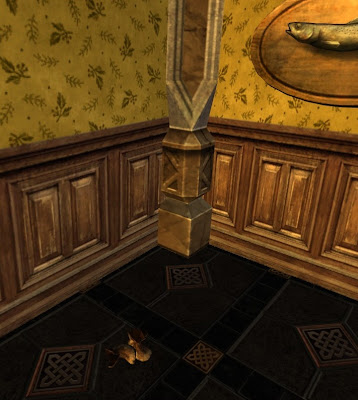My Captain, Leeowyn, has been finishing quests and deeds in Evendim. I really enjoy playing in that area, particularly since the update last year. Admittedly it helps to get things done in Annúminas if you are 75! It allows plenty of opportunity to linger and take in the sights.
Just outside of Annúminas is Men Erain, the "Way of the Kings," where the tombs of many of the Kings of Arnor can be found. The deed, "The Tombs of Evendim," will take you here to explore the location of each tomb. LOTRO has it right, these were indeed the rulers of Arnor, but let's look a bit more at the history of each king of who lies here, as well as those who do not.
Names with Bold/Underline are part of the Tombs of Evendim exploration deed (+1 Fidelity and 5 Turbine Points!). The dates reflect the start and end of rule for each king. The description for some of the kings indicate a "premature death," which is defined in Appendix A as follows: "premature death, in battle or otherwise, though an annal of the event is not always included."
 |
| Haudh Elendil |
2. Isildur - 3441 Second Age-2 Third Age (premature death). Isildur was the eldest son of Elendil, and like his father, was born in Númenor before it fell. His brother was Anárion, and after their exile to the west of Middle Earth, the brothers were given rule of Gondor by their father. It was Isildur who planted a seed from the White Tree of Avallon in Minas Ithil (the Tower of the Moon), which later became known as Minas Morgul after Minas Ithil was conquered by Sauron in 3429 of the Second Age. Isildur and his family escaped and fled north to Elendil, bearing a seedling of the White Tree that he had planted in Minas Ithil. After the overthrow of Sauron in 3441, and the death of his brother Anárion the year before, Isildur gives Gondor to Anárion's son Meneldil, and replants this last seedling of the White Tree in Minas Anor (Tower of the Setting Sun, renamed Minas Tirith). Intending to return north to assume the rule of Arnor, Isildur and his three oldest sons are slain by orcs in the Gladden Fields, and the Ring is lost. Before being overrun, Isildur commanded one of his squires, Ohtar, to flee with the shards of Narsil to Rivendell so the heirlooms of the house of Elendil would survive.
But hold on - if you search Annúminas, you will eventually discover - there is no tomb for Isildur. He is the only one of the Kings of Arnor who has no tomb here in LOTRO. Why is this? Elendil got one - and a nice big one, too - even though his remains were never brought here. Possibly because the remains of Isildur were never recovered? Possibly because his heirs were extremely cheezed about him losing the One Ring? Your guess here is as good as mine!
 |
| Haudh Valandil |
4. Eldacar - 249-339 Third Age
5. Arantar - 339-435 Third Age
6. Tarcil - 435-515 Third Age
7. Tarondor - 515-602 Third Age
 |
| Haudh Valandur |
8. Valandur - 602-652 Third Age (premature death) - Like several of his predecessors, we know virtually nothing about Valandur, except that he was slain at the relatively young age of 190, after ruling Arnor for only 50 years. Players who had been around both before and after the Evendim revamp know that the tomb of this short-reigning king was turned into kergrim central. Two quests take us into the tomb to kill a number of kergrim and to recover what would have been Valandur's sceptre from the chief kergrim, Bone Eater. It is also a wonderful place to grind out the kergrim slayer deeds in Evendim, due to the very fast respawn rate - by the time you get to the bottom and kill the last kergrim, the first ones are ready to pop right back up.
9. Elendur - 652-777 Third Age
 |
| Haudh Eärendur |
What strikes me is how much smaller and considerably less lavish the tombs of the later kings became. Possibly that may be due in part to them not taking part in such great deeds as their earlier sires. But it more likely reflects that even as soon as the Disaster of the Gladden Fields, the Men of Westernesse began to dwindle, as stated by Elrond in The Fellowship of the Ring. Eventually the heirs of Valandil abandoned Annúminas and shifted the ruling seat to Fornost, leaving behind a glorious city that would fall into ruin.
Sources: The Fellowship of the Ring, Appendix A, The Lord of the Rings; The History of Middle Earth (Volume XII: The Peoples of Middle Earth, The Heirs of Elendil); Unfinished Tales








